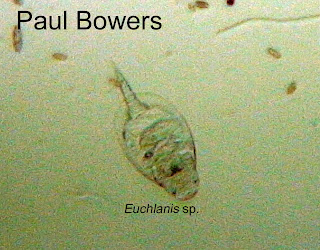I finally got the seed shrimp mentioned in some of my first postings!
pbowers17
Wednesday, November 10, 2010
Above is a type of rotifer, belonging to the genus euchlanis. This species are usually around 0.1-0.5 mm in length, and is common in freshwater environments. (See citation below.) They seem to be able to swim quite well, using their tails to aid them.Thorp, James H.. Ecology and Classification of North American Fresh Water Invertabrae. Academic Press, San Diego, 1987, pg.190
Below is a picture of the aforementioned parimecium:
Parimesium
Above is a parimesium. See citation below. If you look closely, you can see the chloroplasts moving around in cyclical movement, which is the reason I wanted to capture it on video. It feeds on bacteria and loves still water but cannot survive in brackish water. It has one compact micronucleus and two vacuoles
Bick, Hartmat. Ciliated Protoza. World Health Organization, 1972. Academic Press. Geneva, Switzerland, 1972
Wednesday, October 27, 2010
Rotifer sighted, cynobacteria, and tachysoma
Before this week's observation, the following food pellet was inserted into Habitat17: "Atison's Betta Food" made by Ocean Nutrition, Aqua Pet Americas, 3528 West 500 South, Salt Lake City, UT 84104. Ingredients: Fish meal, wheat flower, soy meal, krill meal, minerals, vitamins and preservatives. Analysis: Crude Protein 36%; Crude fat 4.5%; Crude Fiber 3.5%; Moisture 8% and Ash 15%.
This week, I observed several new developments in Habitat17. The above picture shows an organism called a Tachysoma undergoin the process of mitosis. (Patterson) You can see it starting to split into twin organisms.
Another new development was the cynobacteria moving slowly through the water, looking like robotic peices of spaghetti. (Below)
Patterson, D.J., Free-Living Fresh Water Protoza, Manson Publishing, Washington D.C., 1996
 |
| Tachysoma undergoing mitosis |
Another new development was the cynobacteria moving slowly through the water, looking like robotic peices of spaghetti. (Below)
 |
| Cynobacteria |
Patterson, D.J., Free-Living Fresh Water Protoza, Manson Publishing, Washington D.C., 1996
Wednesday, October 20, 2010
Using the new 'Scopes!
This week was the first time using the new specialized lenses for viewing Habitat17. Using this new lens, I was able to focus in on some of the microscopic and transparent organisms of the past week. For the first several minutes, I observed the sea shrimp burrowing through the mud at the bottom of Habitat17. Also, one of the first things I noticed was a juvinile seed shrimp. It was approximately one-fifth the size of the grown ones. Much of my time was spent trying to capture video of the seed shrimp feeding on the plantae in the aquarium. However, they moved too rapidly for me to succeed. I did, however, get several good pictures, which I will post later. The diversity of Habitat17 ranges from the large seed shrimp to extremely small, transparent microbes which I hope to identify in the week to come.
Subscribe to:
Comments (Atom)



